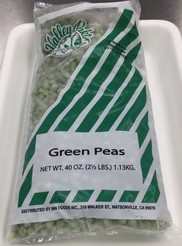USDA Foods from Farm to Plate "All Programs" Edition is Retiring
This will be the last edition of the general "all programs" USDA Foods from Farm to Plate e-letter. Beginning in January 2020 we will continue to feature our monthly "program specific" e-letters which will include the USDA Foods from Farm to Plate: Spotlight on Schools, Household Highlights, and FDPIR Connection.
By retiring the "all programs" e-letter we will be able to feature each program specific e-letter quarterly and provide the most up-to-date information to our stakeholders in a timely manner.

USDA Foods in Schools Photo Contest
Don't forget to send in your 2020 Serving Up USDA Foods Photo Contest Submission by January 15, 2020! Submission details can be found at this link. Please email all submissions to USDAFoods@usda.gov.
Last year's Gold Tray award went to Tuckahoe Common School District, NY. Its Teriyaki Chicken over Noodles featured USDA Foods fajita chicken, spaghetti, broccoli, and oranges.
Show us how you "Serve Up USDA Foods" in your school meals!
|

Trade Mitigation Food Purchase Distribution Program FY2019 Accomplishments
In 2018, USDA announced a Trade Mitigation Food Purchase and Distribution Program (FPDP) in support of the Administration’s priority to support domestic agriculture for fiscal year 2019. FNS worked with AMS to implement a plan to successfully execute the first year of purchases. The vast majority of the foods purchased were delivered to The Emergency Food Assistance Program (TEFAP) outlets including products of great value to food banks such as fresh, fluid milk and fresh produce (e.g., apples, oranges and grapes). Over 900 million pounds across 72 different materials that are valued in excess of $1 billion was purchased in fiscal year 2019.
In addition to TEFAP outlets, the Commodity Supplemental Food Program (CSFP) and the Food Distribution Program on Indian Reservations (FDPIR) received foods not normally available in their food packages. Schools that participate in the National School Lunch Program (NSLP) also had the opportunity to order FPDP food.
As we enter FY2020, a second round of FPDP purchases for up to $1.4 billion is underway. Shipments will begin in January 2020.
|
FDPIR Guide Rate Change
In early 2020, cornmeal, flour, and bakery mix will be consolidated into one category in the Food Distribution Program on Indian Reservations (FDPIR) Monthly Distribution Guide Rate to provide participants with greater variety and flexibility.
Under the new Guide Rate, participants can choose 2 units of yellow cornmeal, blue cornmeal, all-purpose flour, white whole wheat flour, or bakery mix. There is no limit on flour, cornmeal, or bakery mix selection up to the maximum guide rate of 2 units. By consolidating these items, 1 unit was added to the vegetable category, allowing participants to select up to 12 units of vegetables per month instead of 11 units of vegetables.
In addition, frozen peas will be added as a vegetable option in the FDPIR Guide Rate. Frozen peas will be available in a 2.5 lb. bag and one bag of frozen peas will count as 3 units.
IQF frozen peas can be easily added to any recipe and since they are frozen, they have a longer shelf-life compared to fresh vegetables! Here are a few tips on how to properly store and use IQF products:

Storage Tips for IQF Frozen Peas
- Store unopened frozen peas in the freezer.
- For best quality, store unused portion (after opening) in a sealed air-tight container or freezer safe bag to keep out moisture and reduce freezer burn.
Tips for Using IQF Frozen Peas
- Frozen peas are individually-quick frozen, which means, you can open the package, take as much or as little as needed, close the bag and put the rest back in the freezer.
- Frozen peas may be stuck together when removed from the freezer. Use your hands to break them apart before taking out the amount needed.
- Frozen peas can be thawed in the refrigerator or they can be thawed during cooking.
- Always cook frozen peas according to the cooking instructions on the package before serving, even if the peas will be eaten cold. Use frozen peas in salad, stews, soups, or a stir-fry.
|
USDA Foods Refried Beans and Vegetarian Beans Reformulation
At USDA, we regularly use feedback from programs to improve the quality and acceptability of USDA Foods products. Based on feedback, we recently worked to improve the flavor profile of the USDA Foods vegetarian beans and refried beans. As part of the process, USDA defined the required ingredients to ensure a more consistent flavor profile across vendors and to better align with commercial products. USDA evaluated vendor samples in the test kitchen to ensure the products were acceptable and yielded a similar result.
The refried beans now include oil, tomato, garlic, and jalapeno, but the product still has a mild flavor profile. The vegetarian beans now have a more uniform tomato flavor, color, and sauce thickness. The new formulations of both the vegetarian beans and refried beans are starting to be delivered and you may notice that the vendor label looks a little different to reflect the changes. However, please be assured that these products are still the same versatile USDA Foods you are used to receiving, with a slight makeover.
We hope you enjoy these improvements! If you are interested in reading more about the changes to the product requirements, please look at the canned beans specification on the Agricultural Marketing Service website. If you have feedback about these items or other products, please email us at USDAFoods@usda.gov.
USDA and DoD Celebrate 25 Years of Partnership
For 25-years the USDA and the Department of Defense (DoD), Defense Logistics Agency (DLA) has had a successful collaborative partnership that leverages DLA’s contracting services to military bases to also provide weekly deliveries of a variety of nutritious, U.S. grown fresh fruits and vegetables to schools and Indian Tribal Organizations nationwide.
As part of the National School Lunch Program, the USDA DoD Fresh Program is offered to schools in 48 States, the District of Columbia, Guam, Puerto Rico and the Virgin Islands. In 2019, over 45,000 schools received fresh fruits and vegetables from this program, which more than doubled the number of schools participating in 2017.
Recently, DLA published an article titled, Subsistence, USDA partnership sets new high for schools receiving fresh produce, highlighting the partnership with the USDA and the growth in this program since it began in 1995 with eight states.
Guidance Coming for Farm to Food Bank Projects
On October 4, 2019, USDA published a Final Rule with Request for Comments: The Emergency Food Assistance Program (TEFAP): Implementation of the Agriculture Act of 2018. This rule implements several TEFAP provisions of the 2018 Farm Bill, including a requirement that TEFAP State Plans, at the option of the State agency, describe a plan of operation for projects to harvest, process, package, or transport privately donated foods for use by TEFAP emergency feeding organizations (EFOs), also known as Farm to Food Bank Projects. The rule includes specific details on the criteria and process for Farm to Food Bank projects. USDA plans to publish additional guidance to include further details on State Plan amendments, deadlines, and allowable project partners, in addition to an initial allocation of funding by State. To read the Final Rule visit the Federal Register.
Flexibilities for Distributing Increased Amounts of TEFAP Foods
On November 14, 2019, USDA published a memorandum entitled, Questions and Answers about Distribution Procedures in The Emergency Food Assistance Program (TEFAP). The memo outlines current regulatory flexibilities available to State agencies that can be used to distribute the increased amounts of TEFAP foods provided through the Trade Mitigation Food Purchase Distribution Program, now referred to as the Food Purchase Distribution Program (FPDP). State agencies are encouraged to incorporate the flexibilities into their distribution procedures to the maximum extent possible.
USDA Staff in the Field
USDA staff visited USDA Foods vendors and processors in Pennsylvania in September. The first stop was Mickey’s Pizza, which is part of the National Processing Program and uses USDA Foods flour and cheese. The group toured the facility and learned about the company's experience participating in the National Processing Program.
The group also visited Ocean Spray, which is a USDA Foods dried cranberry supplier, and Knouse, which is a USDA Foods applesauce vendor. Each tour was informative and interactive, highlighting the important work done on a daily basis to bring USDA Foods to our customers.
 FNS and AMS staff with Mickey from Mickey's Pizza, a processor in the USDA National Processing Program.
USDA partners with DoD at New Mexico Back to School Conference
USDA staff along with staff from the Department of Defense (DoD) Defense Logistics Agency (DLA) provided an update on the USDA DoD Fresh Fruit and Vegetable Program along with training and tips on how to use the Fresh Fruit and Vegetable Ordering and Receipt System (FFAVORS) at the New Mexico Public Education Department Back to School Conference in Albuquerque, NM on September 19, 2019.
This event gave USDA staff an opportunity to share recent changes to the USDA DoD Fresh program, such as the required reporting by vendors of the state of origin and how this program continues to grow. We discussed the importance of documenting issues with produce quality and condition, availability, or delivery. In addition we discussed reporting of issues to the produce vendor, DLA representative, and the State Distributing Agency and including photos of produce quality issues and product label. DLA Contracting Officers need the documentation to hold vendors accountable to the contract requirements. This information was also shared in a webinar on November 21, “What’s New in the USDA DoD Fresh Program.” Refer to the Webinar Round-Up section for more information.
FDPIR Tribal Leaders and USDA Meet During Intertribal Agriculture Council Conference
On December 10, 2019, USDA Officials met, in consultation, with Tribal leaders to discuss on-going activity and topics related to the Food Distribution Program on Indian Reservations (FDPIR). As part of the discussion, USDA provided an update and received feedback on FDPIR provisions included in the 2018 Farm Bill; a discussion on USDA foods, including traditional foods and fresh produce included in the food package; technology updates impacting food ordering and management at the local Tribal level; and a status update on the USDA-FNS regional realignment. USDA and Tribal leaders agreed to continue the formal dialogue and will schedule additional consultation meetings during FY 2020.

What's New in the USDA DoD Fresh Program?
On November 21, 2019 USDA hosted a webinar for USDA Regional Office Staff and State Distributing Agency Staff who manage USDA Foods in Schools programs that discussed recent updates and provided guidance on the USDA Department of Defense (DoD) Fresh Fruit and Vegetable Program. Highlights included: program allocations, adding new schools to Fresh Fruits and Vegetables Order Receipt System (FFAVORS), receipting orders in FFAVORS, and managing School Food Authority (SFA) expectations. A recording of the webinar is available at this link.
|
What's New in WBSCM: Updates for eINV Receipting
In August, WBSCM implemented a streamlined process called electronic invoicing (eINV) that impacts the receipting screen and functionality for materials shipped directly from a commodity vendor. There are no changes to receipting deliveries from the multifood warehouses.
Although the steps for receipting are essentially the same, separate versions of the work instructions with screenshots and applicable notes are available in WBSCM for both receipting processes:
- For multifood orders and direct shipment orders purchased prior to August 2019, refer to the Enter Domestic Shipment Receipt work instruction.
- For all other direct shipment orders, refer to the Enter and Modify Domestic Shipment Receipt (eINV) work instruction. This includes additional steps which allow a user to modify a recently entered receipt without requesting assistance.
Users are encouraged to double-check where they are entering quantities as the column order differs between the new and previous screens. Additionally, in the new receipting screen, good quantity fields are pre-populated with the value from the ASN, if available. This quantity can be changed as needed.
Refer to the Release Notes for a summary of other recent changes, related work instructions and job aids, and suggested workarounds for related issues that will be addressed in a future release.
WBSCM documentation, including work instructions and release notes, can be found in WBSCM at Help > Training.
If you have any questions, please contact the WBSCM Service Desk at WBSCM.servicedesk@CACI.com or call (877) 927-2648.
Featured Tip: Entering eINV Receipt Before Vendor Enters ASN
With the new electronic invoicing (eINV) process, customers can enter receipts even when the status of the PO line is “Missing ASN.” WBSCM will receive the submitted receipt, but some functionality is limited until both the goods receipt and ASN are available.
Modifying Receipt: Generally, customers can review recently entered receipts and make changes to the quantities, date, and other details. When the ASN is not available, the user will not be able to select the line or enter changes. Customers should wait a couple days for the vendor to enter the ASN. If the receipt can no longer be accessed, contact WBSCM.servicedesk@CACI.com for assistance. Refer to the Enter and Modify Domestic Shipment Receipts (eINV) work instruction in WBSCM (Help > Training > Work Instructions) for further guidance.
 Fig 1: Receipt cannot be selected or edited when ASN has not been entered.
Reports: At this time, receipts will not appear on the Received Shipment Report until the ASN is also available. Until this issue is addressed in a future release, there are two workarounds to confirm that a receipt was submitted and/or to review its details:
- Recently entered eINV receipts for a specific order are available through the Enter Shipment Receipt transaction (see above). In the eINV_View, the Receipt Status column will show “Recpt Processed” to indicate that the receipt has been submitted.
- To view receipt information in a report form, users can use the Order Status Report or Requisition Status Report. Fields that include information from the receipt are available but may not be readily visible, depending on the view and custom display settings for the report. To create a customized view for submitted receipt information, refer to the Reporting Navigation job aid in WBSCM (Help > Training > Job Aids > Reports).
 Fig 2: Order Status Report includes receipt details, accessed by scrolling to the right.
If you have any questions, please contact the WBSCM Service Desk at WBSCM.servicedesk@CACI.com or call (877) 927-2648.
System Reminders
- 12/20/2019 – AIS Release 12.2019
- 12/20/2019 – WBSCM Enhancement Release 2019R4.4.12
- 1/12/2020 – FFAVORS Release 2.10
- 1/31/2020 – WBSCM Maintenance Release 2020R4.0.01
Planned dates for system activities are subject to change.
|